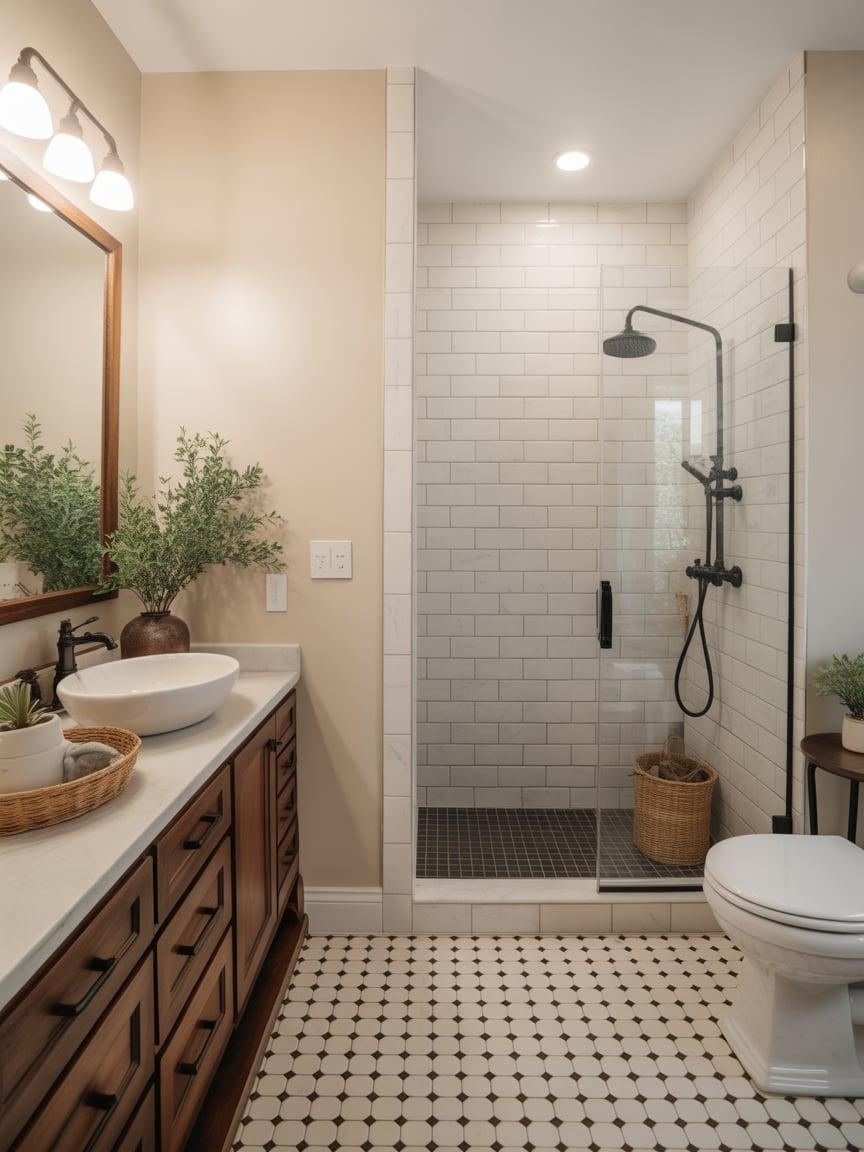Simple Design Choices That Make a Huge Difference in Small Bathrooms

Small bathrooms can feel limiting, but they don’t have to be. With the right design choices, even the most compact space can feel open, stylish, and practical. The beauty of bathroom design is that small changes often make a big impact. Whether you’re working with a powder room tucked under the stairs or a narrow main bath in an older home, thoughtful updates can transform the experience.
In this article, we’ll look at simple but effective design strategies that help maximize space, improve functionality, and create a bathroom that feels much larger than it actually is.
1. Light Colors to Open Up the Room
Color is one of the easiest and most affordable tools you can use to change the perception of space. Lighter shades reflect more light, which makes walls recede visually and gives a sense of openness.
-
Whites and off-whites: Classic choices that never go out of style. They instantly brighten a room.
-
Soft grays or beiges: Neutral tones that add warmth without making the space feel smaller.
-
Pastels: Soft blues, greens, or blush tones add personality without overwhelming the eye.
Pairing light walls with a white or light-toned vanity creates a seamless look that reduces visual clutter. If you love bold colors, consider using them sparingly as accents—perhaps in towels, artwork, or a single feature wall.
2. Strategic Use of Mirrors
Mirrors are more than just functional. They’re powerful design tools that can make a small bathroom feel twice its size.
-
Large wall mirrors: Placing a big mirror above the vanity reflects both natural and artificial light.
-
Full-height mirrors: A mirror that runs from countertop to ceiling draws the eye upward, emphasizing vertical space.
-
Opposite placement: Positioning a mirror opposite a window doubles the effect of natural light.
Frameless or minimal-frame mirrors are especially effective in small bathrooms, as they avoid unnecessary lines that break up the space.
3. Smart Storage Solutions
One of the main challenges in small bathrooms is finding a place for everything. Clutter instantly makes a room feel smaller, so efficient storage is key.
-
Floating vanities: These provide hidden storage while leaving open floor space underneath, which creates the illusion of more room.
-
Recessed shelving: Built into the wall, recessed niches keep shampoo bottles and toiletries within reach without protruding into the shower.
-
Over-the-toilet cabinets: Perfect for storing towels or extra supplies in an otherwise unused area.
-
Drawer organizers: Simple trays or dividers keep small items like brushes, toothpaste, or makeup from scattering.
By keeping surfaces clear, you allow the bathroom to breathe visually.
4. Glass Shower Doors Instead of Curtains
Shower curtains, while practical, can cut off a significant portion of your bathroom visually. Glass shower doors—especially frameless designs—let the eye travel further, making the room appear more expansive.
-
Clear glass: Best for small bathrooms since it doesn’t interrupt sight lines.
-
Sliding doors: A good choice for narrow spaces where a swinging door would be awkward.
-
Minimal hardware: Slim handles and hinges keep the look streamlined.
If a glass enclosure isn’t possible, consider a lighter, translucent shower curtain rather than a heavy or dark one.
5. Vertical Emphasis with Tiles
Tile choice plays a big role in how your bathroom feels. Instead of thinking only about color or pattern, consider the direction of the tile layout.
-
Vertical subway tiles: These draw the eye upward, making the ceiling feel higher.
-
Large format tiles: Fewer grout lines create a cleaner look and reduce visual clutter.
-
Accent stripes: A vertical stripe of contrasting tile in the shower can add height.
Keeping grout color close to the tile shade also helps the walls feel less busy and more expansive.
6. Lighting That Works Harder
Good lighting is essential in small bathrooms, especially since many don’t have windows. A single overhead fixture often leaves corners dark and uninviting.
Layer your lighting to eliminate shadows and highlight features:
-
Vanity lights: Mounted at eye level on either side of the mirror, these provide flattering illumination for grooming.
-
Recessed ceiling lights: Brighten the overall space evenly.
-
Accent lights: LED strips under a floating vanity or along shelving add depth and a modern touch.
Warm white bulbs usually work best, as they soften the space while still offering clarity.
7. Space-Saving Fixtures
Modern bathroom products are designed with small spaces in mind. Choosing the right fixtures can free up valuable square footage.
-
Compact toilets: Shorter projection toilets save several inches without sacrificing comfort.
-
Corner sinks: Ideal for bathrooms where every inch counts.
-
Wall-mounted faucets: These reduce the depth of the vanity needed below.
Even small adjustments, like replacing a bulky pedestal sink with a slim vanity, can improve both function and aesthetics.
8. Keep the Floor Visible
The more flooring you see, the larger your bathroom will appear. Avoid blocking sightlines with heavy cabinets or storage bins.
Floating vanities, pedestal sinks, and wall-mounted toilets all contribute to an airy look. If you need storage baskets, try open shelving that allows some floor visibility underneath.
A continuous floor surface, such as large tiles or waterproof vinyl planks, also creates a sense of flow that expands the room visually.
9. Minimalism in Accessories
It’s tempting to fill a bathroom with decorative items, but less is often more. Small bathrooms especially benefit from a minimalist approach.
-
Limit countertop accessories to one or two functional pieces.
-
Use a single statement item, like a stylish mirror or artwork, instead of many smaller pieces.
-
Opt for uniform towels rather than multiple colors or patterns.
This doesn’t mean the space has to feel bare—it just ensures every element contributes to a clean and cohesive look.
10. When to Consider Professional Help
While many of these changes are simple DIY updates, larger transformations may require expert guidance. A designer or contractor can help with layout changes, custom storage, or plumbing adjustments that maximize space efficiency.
For homeowners in Texas, for example, searching for bath remodel Austin services can connect you with professionals who specialize in making compact bathrooms functional and stylish. Even modest updates guided by an expert eye can dramatically enhance both the look and usability of the space.
Final Thoughts
A small bathroom doesn’t have to feel cramped or uninspiring. With smart design choices—light colors, mirrors, glass shower doors, vertical tiling, and efficient lighting—you can create an environment that feels open, airy, and welcoming. Combine these strategies with thoughtful storage and minimal accessories, and your bathroom can transform into one of the most impressive rooms in your home.
Ultimately, the goal is balance. Every design decision should contribute to both functionality and aesthetics. Even the smallest changes, like adjusting your color palette or switching out a curtain for glass, can have a surprisingly big impact. By layering these ideas, you can turn a small bathroom into a beautiful, comfortable space that feels much larger than it is.
Learn More about website







